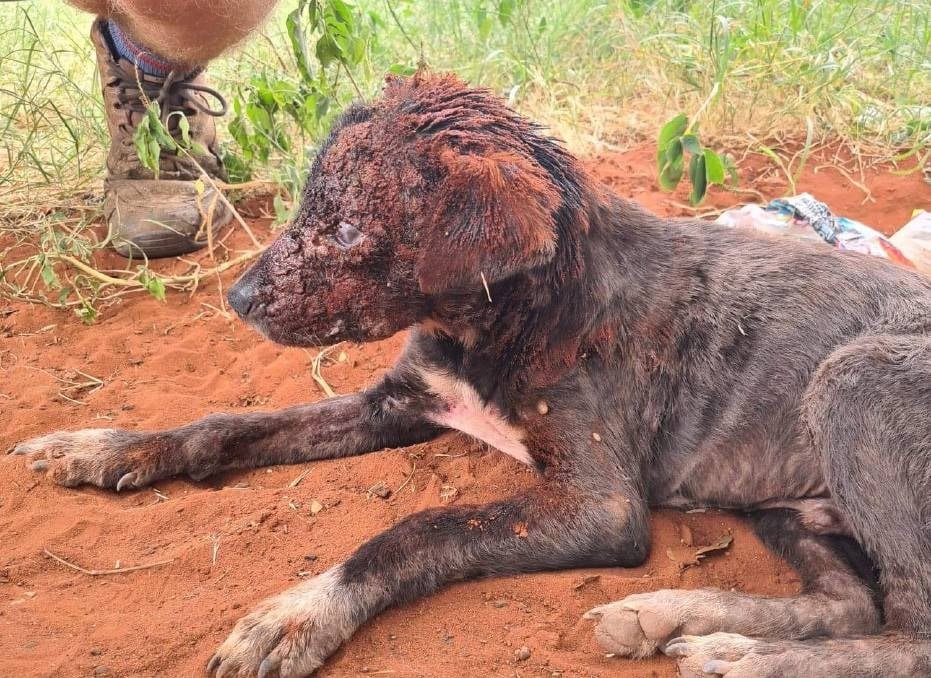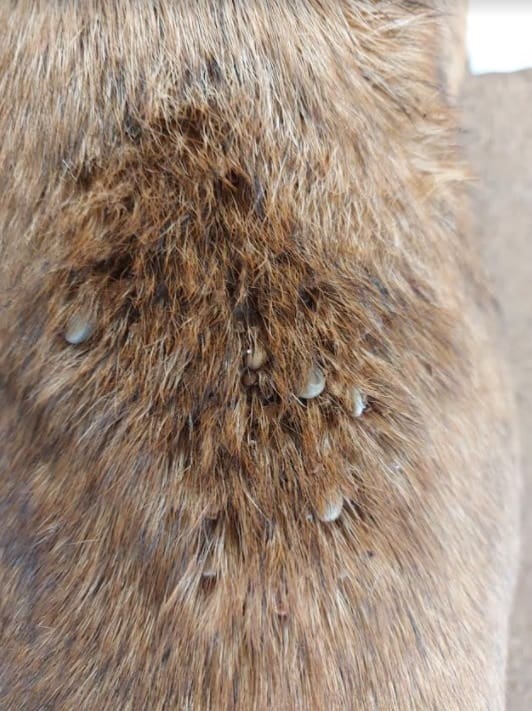
A dog affected by the tick-borne disease ehrilichiosis. Image – Facebook, Hervey Bay Rural Supplies.
VICTORIAN dog owners and veterinarians have been advised to be on the lookout for a new disease spread by brown dog ticks, after a case was reported at Horsham.
The Horsham detection of ehrlichiosis in a dog from the Northern Territory is the first case of the disease found in an Australian-born dog in Victoria.
Ehrlichiosis was found for the first time in an Australian dog in the Kimberley region in mid-2020. Since then, it has spread around the country and now found in most states and territories, including New South Wales and South Australia.
Victoria’s Chief Veterinary Officer Dr Graeme Cooke urged all Victorian dog owners and veterinarians to be on the lookout for the disease.
Ehrlichia canis (E. canis) cannot be passed directly from dog to dog, except via infected ticks, and dogs which have been diagnosed and are undergoing veterinary treatment for ehrlichiosis do not pose a health risk in transferring the disease to other dogs.
Dr Cooke said the Horsham dog was rehomed as a pet from an infected area and has been on a tick control program since it arrived in the Wimmera city.
“The dog is very healthy and it has also received antiobiotic treatment, which is a way of clearing up the disease.
“Nor has there been any reports of ticks being found on the dog.”
This meant that the likelihood of the dog dropping any infected ticks in Victoria is “very low,” he said.
“However, it is a reminder to people who are rehoming dogs or moving dogs from infected areas of Australia to have a good tick preventative treatment program and possibly if you don’t much about the history of the dog, have it tested before it leaves that area.”
Dr Cooke said Agriculture Victoria had initiated a program of free testing and tick identification of dogs at veterinarians to generate data on the level or risk is, or the level of infection might be in Victoria.
“That (program) has been going for some months and it was that that picked this case up.”

Ticks on a dog. Image – Barkly Vet Practice.
Dr Cooke said common signs of ehrlichiosis could include fever, lethargy, eye changes such as conjunctivitis, cloudy or red eyes; abnormal bleeding and swellings, small spots or bruising; and swellings on the body and limbs.
“When detected early, antibiotics may be used to treat the disease,” Dr Cooke said.
“Prevention is crucial as there is no vaccine for the disease.
“Protect your dogs from ehrlichiosis by regularly checking them for ticks, using effective tick control and seeking veterinary advice promptly if they become unwell,” he said.
Dr Cooke said owners should regularly check their dog for ticks by running fingers through the coat, on the skin, paying attention to the head, neck, ears, chest, between their toes and around their mouth and gums.
“Be particularly vigilant if you’re taking your dog out bush and travelling interstate.”
Dr Cooke said ahrlichiosis is a notifiable disease in Victoria, which means it must be reported to the Emergency Animal Disease Watch Hotline on 1800 675 888 when suspected.
“If your dog is unwell or you find any abnormal bumps or ticks, make sure you promptly arrange to take your dog to your vet. Discuss with your vet the testing system in place for ehrlichiosis in Victoria.
“Put a tick in a clean resealable bag and take it to your local veterinarian to submit for identification. Freeze the bag with the tick first if you cannot take it to a vet immediately. If you are unsure about what is an appropriate tick control product to use, then consult your Veterinary advisor.”
Disease can be serious but preventable and treatable
Dr Kelsey Fyffe at the Barkly Veterinary Practice at Tennant Creek in the Northern Territory said the Horsham dog would not be dropping infected ticks if it was undergoing tick prevention treatment. She advised dog owners to get their dogs on a tick prevention program, involving a tick repellent collar and/or medication available from veterinarians.
She said a dog could become infected with the disease through one bite from an infected tick.
“So the collar in some ways is better if you have a dog that is tolerant of that; the collar itself is adequate to stop the ticks from getting on your dog.
“In an ideal world, the perfect scenario, you would go for both,” she said.
“If you’ve got dogs where you know you’ve got a tick problem, then it would be really worth having them on the tablet to kill any ticks that are coming and going, because if it gets into the tick population we need to try to eliminate that tick population.”
Dr Fyffe said the disease is treatable, especially if cases are identified early. She advised people moving dogs out of or into high tick zones to get them inspected for ticks.
On rare occasions humans can become infected through the bite of an infected tick. Please seek medical advice if you feel unwell after being exposed to ticks.
For more information on ehrlichiosis (or e-canis), visit the Agriculture Victoria website or call the Customer Contact Centre on 136 186.

Thank you for including an article about what is a serius problem for all owners of livestock working dogs.